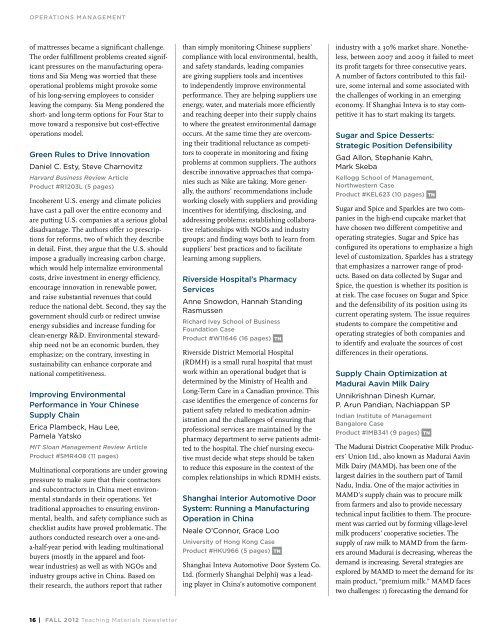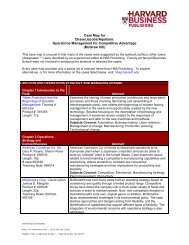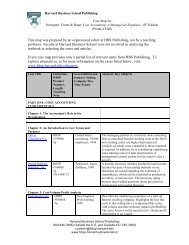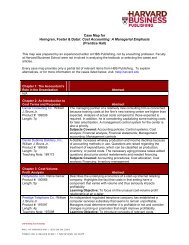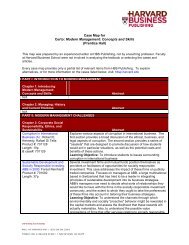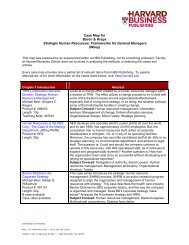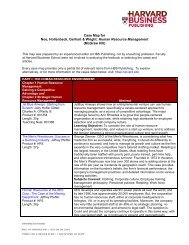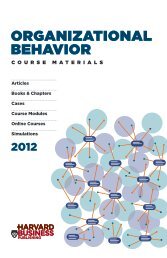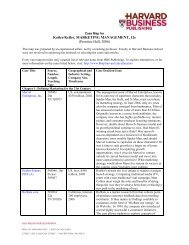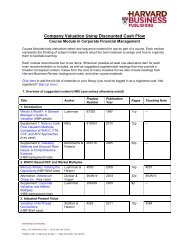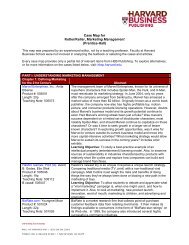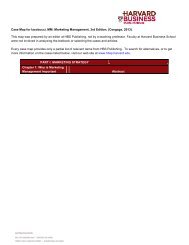teAcHing MATErIAlS - Harvard Business School Press
teAcHing MATErIAlS - Harvard Business School Press
teAcHing MATErIAlS - Harvard Business School Press
Create successful ePaper yourself
Turn your PDF publications into a flip-book with our unique Google optimized e-Paper software.
OPERATIONS MANAGEMENT<br />
of mattresses became a significant challenge.<br />
The order fulfillment problems created significant<br />
pressures on the manufacturing operations<br />
and Sia Meng was worried that these<br />
operational problems might provoke some<br />
of his long-serving employees to consider<br />
leaving the company. Sia Meng pondered the<br />
short- and long-term options for Four Star to<br />
move toward a responsive but cost-effective<br />
operations model.<br />
Green Rules to Drive Innovation<br />
Daniel C. Esty, Steve Charnovitz<br />
<strong>Harvard</strong> <strong>Business</strong> Review Article<br />
Product #R1203L (5 pages)<br />
Incoherent U.S. energy and climate policies<br />
have cast a pall over the entire economy and<br />
are putting U.S. companies at a serious global<br />
disadvantage. The authors offer 10 prescriptions<br />
for reforms, two of which they describe<br />
in detail. First, they argue that the U.S. should<br />
impose a gradually increasing carbon charge,<br />
which would help internalize environmental<br />
costs, drive investment in energy efficiency,<br />
encourage innovation in renewable power,<br />
and raise substantial revenues that could<br />
reduce the national debt. Second, they say the<br />
government should curb or redirect unwise<br />
energy subsidies and increase funding for<br />
clean-energy R&D. Environmental stewardship<br />
need not be an economic burden, they<br />
emphasize; on the contrary, investing in<br />
sustainability can enhance corporate and<br />
national competitiveness.<br />
Improving Environmental<br />
Performance in Your Chinese<br />
Supply Chain<br />
Erica Plambeck, hau Lee,<br />
Pamela Yatsko<br />
MIT Sloan Management Review Article<br />
Product #SMR408 (11 pages)<br />
Multinational corporations are under growing<br />
pressure to make sure that their contractors<br />
and subcontractors in China meet environmental<br />
standards in their operations. Yet<br />
traditional approaches to ensuring environmental,<br />
health, and safety compliance such as<br />
checklist audits have proved problematic. The<br />
authors conducted research over a one-anda-half-year<br />
period with leading multinational<br />
buyers (mostly in the apparel and footwear<br />
industries) as well as with NGOs and<br />
industry groups active in China. Based on<br />
their research, the authors report that rather<br />
16 | fAll 2012 Teaching Materials Newsletter<br />
than simply monitoring Chinese suppliers’<br />
compliance with local environmental, health,<br />
and safety standards, leading companies<br />
are giving suppliers tools and incentives<br />
to independently improve environmental<br />
performance. They are helping suppliers use<br />
energy, water, and materials more efficiently<br />
and reaching deeper into their supply chains<br />
to where the greatest environmental damage<br />
occurs. At the same time they are overcoming<br />
their traditional reluctance as competitors<br />
to cooperate in monitoring and fixing<br />
problems at common suppliers. The authors<br />
describe innovative approaches that companies<br />
such as Nike are taking. More generally,<br />
the authors’ recommendations include<br />
working closely with suppliers and providing<br />
incentives for identifying, disclosing, and<br />
addressing problems; establishing collaborative<br />
relationships with NGOs and industry<br />
groups; and finding ways both to learn from<br />
suppliers’ best practices and to facilitate<br />
learning among suppliers.<br />
Riverside Hospital’s Pharmacy<br />
Services<br />
Anne Snowdon, hannah Standing<br />
Rasmussen<br />
Richard Ivey <strong>School</strong> of <strong>Business</strong><br />
Foundation Case<br />
Product #W11646 (16 pages) tn<br />
Riverside District Memorial Hospital<br />
(RDMH) is a small rural hospital that must<br />
work within an operational budget that is<br />
determined by the Ministry of Health and<br />
Long-Term Care in a Canadian province. This<br />
case identifies the emergence of concerns for<br />
patient safety related to medication administration<br />
and the challenges of ensuring that<br />
professional services are maintained by the<br />
pharmacy department to serve patients admitted<br />
to the hospital. The chief nursing executive<br />
must decide what steps should be taken<br />
to reduce this exposure in the context of the<br />
complex relationships in which RDMH exists.<br />
Shanghai Interior Automotive Door<br />
System: Running a Manufacturing<br />
Operation in China<br />
Neale O’Connor, Grace Loo<br />
University of Hong Kong Case<br />
Product #HKU966 (5 pages) tn<br />
Shanghai Inteva Automotive Door System Co.<br />
Ltd. (formerly Shanghai Delphi) was a leading<br />
player in China’s automotive component<br />
industry with a 30% market share. Nonetheless,<br />
between 2007 and 2009 it failed to meet<br />
its profit targets for three consecutive years.<br />
A number of factors contributed to this failure,<br />
some internal and some associated with<br />
the challenges of working in an emerging<br />
economy. If Shanghai Inteva is to stay competitive<br />
it has to start making its targets.<br />
Sugar and Spice Desserts:<br />
Strategic Position Defensibility<br />
Gad Allon, Stephanie Kahn,<br />
Mark Skeba<br />
Kellogg <strong>School</strong> of Management,<br />
Northwestern Case<br />
Product #KEL623 (10 pages) tn<br />
Sugar and Spice and Sparkles are two companies<br />
in the high-end cupcake market that<br />
have chosen two different competitive and<br />
operating strategies. Sugar and Spice has<br />
configured its operations to emphasize a high<br />
level of customization. Sparkles has a strategy<br />
that emphasizes a narrower range of products.<br />
Based on data collected by Sugar and<br />
Spice, the question is whether its position is<br />
at risk. The case focuses on Sugar and Spice<br />
and the defensibility of its position using its<br />
current operating system. The issue requires<br />
students to compare the competitive and<br />
operating strategies of both companies and<br />
to identify and evaluate the sources of cost<br />
differences in their operations.<br />
Supply Chain Optimization at<br />
Madurai Aavin Milk Dairy<br />
Unnikrishnan Dinesh Kumar,<br />
P. Arun Pandian, Nachiappan SP<br />
Indian Institute of Management<br />
Bangalore Case<br />
Product #IMB341 (9 pages) tn<br />
The Madurai District Cooperative Milk Producers’<br />
Union Ltd., also known as Madurai Aavin<br />
Milk Dairy (MAMD), has been one of the<br />
largest dairies in the southern part of Tamil<br />
Nadu, India. One of the major activities in<br />
MAMD’s supply chain was to procure milk<br />
from farmers and also to provide necessary<br />
technical input facilities to them. The procurement<br />
was carried out by forming village-level<br />
milk producers’ cooperative societies. The<br />
supply of raw milk to MAMD from the farmers<br />
around Madurai is decreasing, whereas the<br />
demand is increasing. Several strategies are<br />
explored by MAMD to meet the demand for its<br />
main product, “premium milk.” MAMD faces<br />
two challenges: 1) forecasting the demand for


